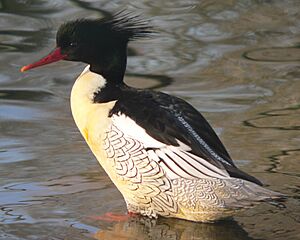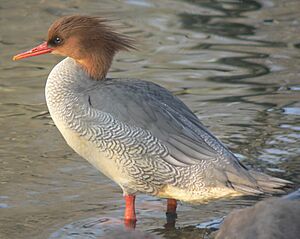Scaly-sided merganser facts for kids
Quick facts for kids Scaly-sided merganser |
|
|---|---|
 |
|
| Adult male | |
 |
|
| Adult female | |
| Conservation status | |
| Scientific classification | |
| Genus: |
Mergus
|
| Species: |
squamatus
|
The scaly-sided merganser, also called the Chinese merganser, is a special type of duck. Its scientific name is Mergus squamatus. This bird is endangered, meaning there are not many left. It lives in places like Manchuria and Southeast Siberia. It makes its nests in the northern parts and flies south for the winter.
Contents
What Does It Look Like?
This amazing sea duck has a thin, red beak. Its sides and back part (called the rump) have a cool, scaled pattern. Both male and female mergansers have a crest of long, wispy feathers. In adult males, these feathers can reach almost to their shoulders. In females and young birds, the crest is shorter.
An adult male has a black head and neck. Its chest and belly are white. Its back and wings are dark, almost black. But the inside of its wings are white. The scaled pattern on its sides is also black. Its tail is a medium gray color.
The female has a light brown head. Instead of black, her body is mostly gray. Both male and female birds have orange-red legs. Their eyes are dark brown.
Where Does It Live and What Does It Do?
These ducks like to breed in rivers found in old forests. These forests are mostly in the southeastern Russian Far East. Some might also live in North Korea. In China, they are found in the Changbai Mountains and a small area in the Lesser Xingan Mountains. Most of these birds (about 85%) breed in the Russian Far East.
Scaly-sided mergansers are migratory birds. This means they fly to different places for different seasons. They spend their winters in central and southern China. A few also go to Japan, South Korea, Taiwan, northern Vietnam, Myanmar, and Thailand. They arrive at their breeding spots in March, as soon as winter ends. They leave in mid-November when it starts to get cold.
Daily Life and Diet
This bird is shy and easily scared. It prefers medium-sized rivers that wind and turn through wide mixed forests in the mountains. They can live up to 1,000 meters (about 3,300 feet) above sea level.
During the day, these birds often move upstream (against the river flow). They do this when they are scared or when they are looking for food. Moving upstream helps them find prey. They catch food from the riverbed gravel using their special serrated (saw-like) beak.
Often, they dive underwater to catch their food. They stay underwater for about 15 to 30 seconds. Then they come up for only a few seconds before diving again. In shallow water, they only put their heads underwater. They do not "upend," which means tipping their body upside down with their tail in the air.
These birds are not very social when they are breeding. But in autumn and winter, they gather in small groups. Even in their winter homes, it's rare to see more than a dozen birds together.
They spend most of the day looking for food. Around noon, they take a break to rest. They also preen (clean their feathers) and spend time with other ducks. They do this on the river banks, where they also sleep.
The scaly-sided merganser eats water animals. These include arthropods (like insects), frogs, and small to medium-sized fish. They especially like stonefly larvae and giant caddisfly larvae. These make up most of their diet when available. They eat beetles and crustaceans (like crabs or shrimp) less often. Crustaceans might be more important in autumn.
As summer goes on, more aquatic insect larvae hatch. So, fish become a bigger part of their diet. They like fish such as the dojo loach and the lenok. Sometimes, they eat lampreys, sculpins, or Arctic grayling. This shows they are "opportunistic feeders." This means they will eat almost any fish that is the right shape and size.
Nesting and Reproduction
Scaly-sided mergansers build their nests in trees. This is common for ducks like mergansers and goldeneyes. They prefer trees such as daimyo oak, Chozenia, Linden, and Ussuri poplar. They can also easily breed in special nest boxes. These boxes are placed along rivers where forests have been cut down.
These ducks live in the same areas as Mandarin ducks. They might compete for nesting holes. Neither duck can dig their own holes. In winter, scaly-sided mergansers might compete with other ducks. These include common mergansers and common goldeneyes.
Why It Is Endangered
The IUCN (International Union for Conservation of Nature) says this bird is endangered. Its numbers dropped a lot in the 1960s and 1970s. This was because of the loss of old forests in its home range. This was especially true along the main rivers in Russia.
Today, the biggest dangers are illegal hunting, getting caught in fishing nets (especially ghost nets left behind), and river pollution. Also, forests are still being destroyed (called deforestation).
The IUCN says there are fewer than 5,000 adult and young birds left. Most of these (85%) are found in the Primorye and South Khabarovsk regions of Russia.
A worldwide count was done in 2014 in Russia and China. The number for North Korea was guessed. Counting birds in their wintering areas is not helpful. The best way to know the total number is to count them in their breeding areas. Rivers in Central China, especially parts of the Yangtze River, and all rivers in South Korea are known wintering spots.
Losing their homes in China has made their breeding areas smaller. It has also broken them up into separate parts. In Russia, the population seems to have stayed steady since the 1900s.
What Can We Do to Help?
In 2012, experts studied the dangers to the scaly-sided merganser in winter. They found problems like sand mining, fishing, and destroying plants along riverbanks. Other threats include their homes being broken up and water pollution.
To help these birds, here are some ideas:
- Put up artificial nest boxes for them.
- Tell local people about the merganser's endangered status.
- Control fishing to protect the birds.
- Protect the important places where they live.
- Control how people use the breeding rivers for fun.
- Manage river water levels in ways that help the merganser.
- Count the birds every year in key breeding rivers.
See also
- Crested shelduck, possibly extinct waterfowl from the same region


